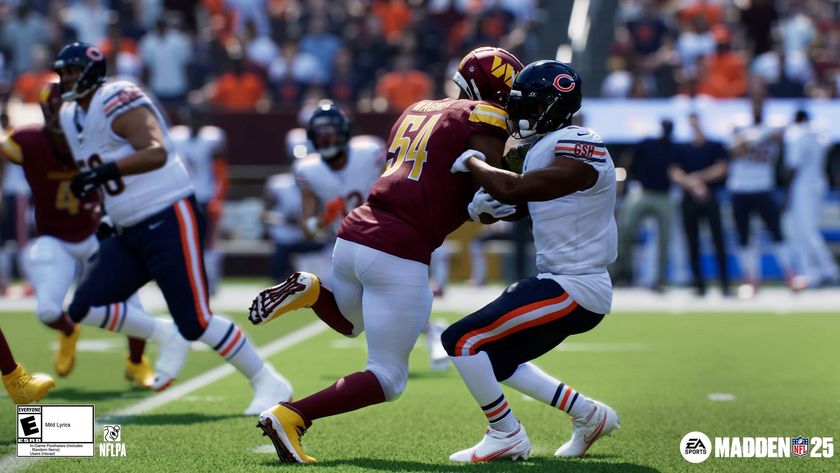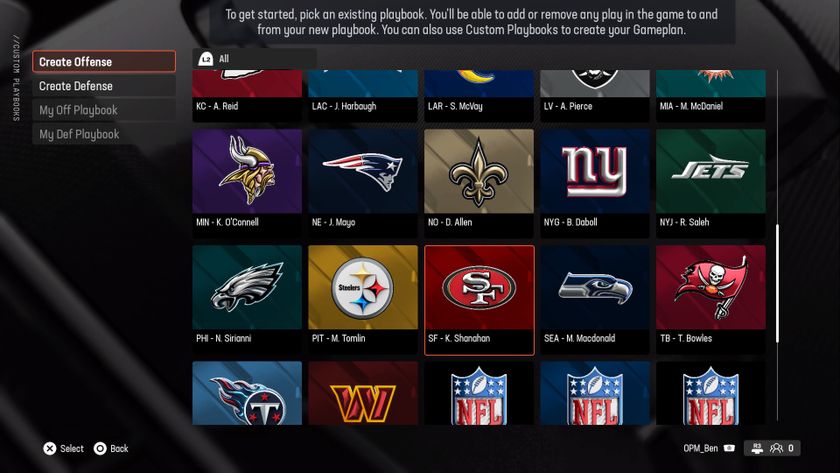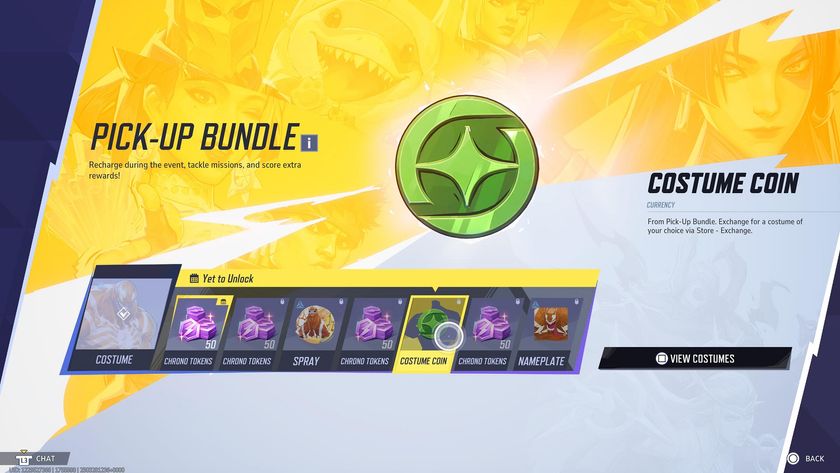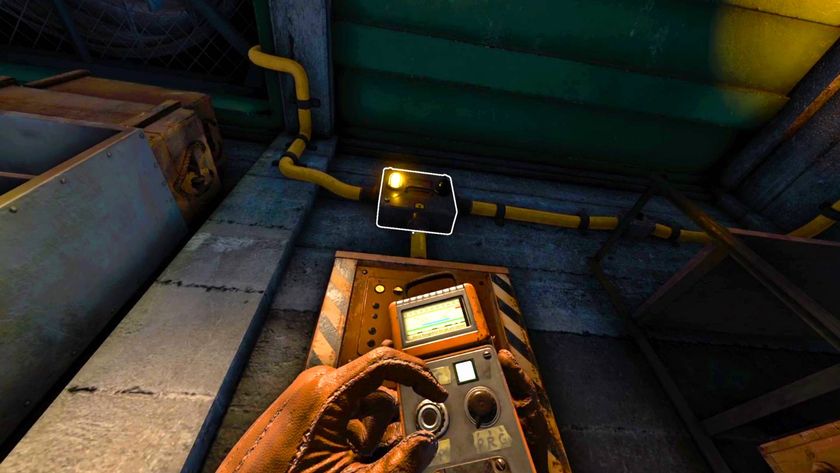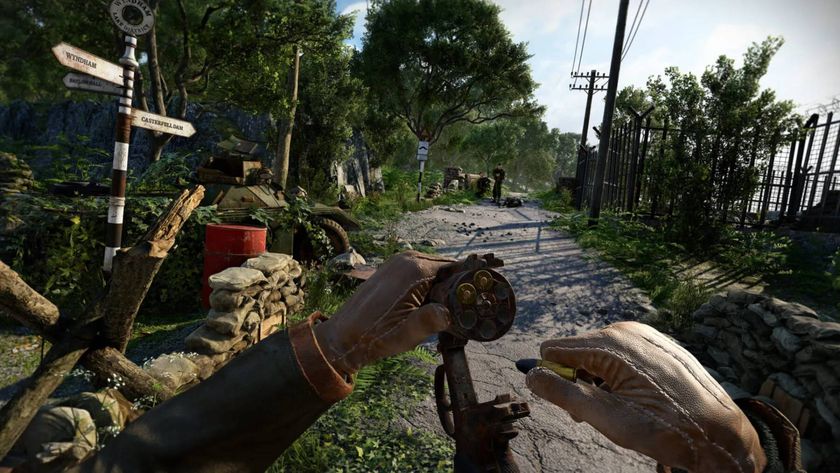Madden NFL 13 connected careers guide
Follow our advice, and you’ll be headed for the Hall of Fame in no time.
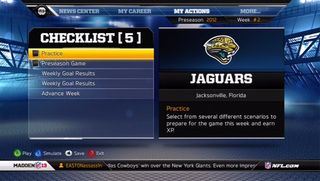
Season’s Start (Player)
Now that you’ve officially begun your career as a player in the NFL, it’s time to start looking at the season ahead. Right off the bat, you’ll be given goals by the phantom ownership based solely on the team you’ve inherited. If you’re a High Draft Pick on a terrible team, your goals will put you to the test. If you’re an Undrafted player, you won’t have nearly as much pressure to succeed right away. There are also smaller game-to-game, and larger overall career goals to meet, but they won’t cost you your job if you don’t complete them.
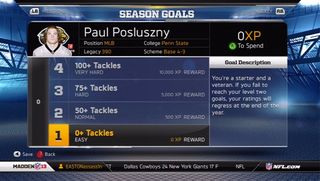
Goals
Under the My Career tab, you’ll find a listing of you goals, your Legacy score, and how much experience you’ve earned to this point. By selecting the goals tab, you can view your season goals, weekly goals, milestone goals, and how much experience you’ll be rewarded with upon accomplishing each one.
Every year you’ll be given four season goals. You won’t get the experience from accomplishing those goals until after the Super Bowl is played, regardless of your making it to the title game or not. The goals are laid out by how easy they are to complete, with the level four goal being considered a healthy challenge. Based on your performace, these goals will change year to year. For example, your level four goal as a rookie quarterback is to throw for 3000 yards. If you happen to succeed, that number increases the following year, and can eventually become as lofty as winning the Super Bowl.
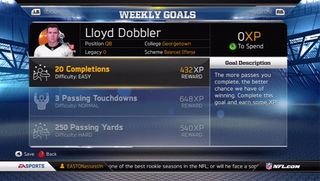
To keep a hold of your job, you must at complete at least the level two goal. Failure to meet even that standard could (and most likely will) result in your release from the team. As a rookie, you’ll be under contract for a few years, so job security is pretty much handed to you as long as you can perform. You could be benched, but you won’t be outright cut unless you ask to be, or fail to meet your goals. Should you be cut loose, either by your own request or at the team’s behest, there’s still a chance another team could sign you. However, if you are not signed by the end of the free agency period, you are forced to retire your player.
Though you can only earn your season goal experience once a year, you can obtain experience from the game-to-game goals and milestone goals multiple times in a season.
The game goals are fairly simple to earn, and are a great way to obtain experience quickly and efficiently. You’ll only have a few goals to meet, and they don’t change during a given year. These goals are mostly tied to the team’s performance, and task you with getting multiple sacks, passing/rushing touchdowns, or meeting certain yardage requirements. The game goals don’t appear to offer much in the way of experience at first glance, but when you can earn say 300 XP for every game you net 23 completions, the points rack up over the course of 16-20 games.
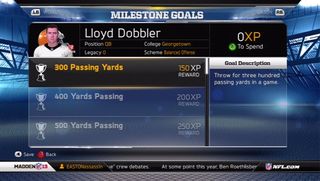
Milestone goals are a little more difficult to meet. These goals are cumulative over the course of a season and career, and again, you can meet some multiple times in a season. Goals like staring all sixteen games, or tallying a specific amount of rushing yards during the year reward you for being proficient. Lengthier goals like winning multiple playoff games or winning MVP awards reward you for not just being good, but being consistently good. These goals will vary by position, but will be the same no matter what team you land on.
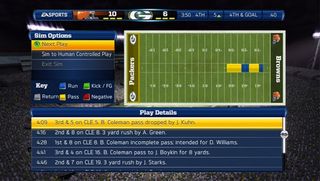
Weekly Activities
Once you’ve gotten a grasp of what you can and need to accomplish during the year, it’s time to get the ball rolling on playing games. Every week, you’ll have a few activities to complete that not only impact your team immediately, but in the long run as well. All of your weekly activities can be viewed under the My Actions tab on the menu.
Unlike the coach Connected Career, your weekly activities are limited to just you. There are no roster management concerns to worry about at any time. You can practice. You can play the games. You can progress your player. That’s it.
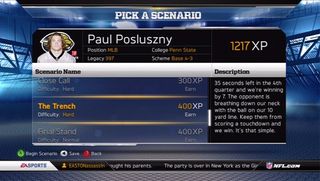
Practice
In previous Maddens, you could practice with your team all you wanted, but it didn’t really have any benefits. In Madden NFL 13, practicing every week gives you the opportunity to earn experience. There are multiple scenarios the game gives you the option of trying out, each with varying degrees of difficulty and rewards. Some of the practice options aren’t really worth the effort for the payout (full game for 1000XP), but the smaller challenges (like the two-minute drill) are a good way to gain additional experience points quickly.
You don’t have to practice if you don’t feel like the reward isn’t worth it, though even if you lose the challenge, you are still given a smaller amount of bonus experience. It should be noted though that unlike in the coach Connected Career, every little bit of experience helps turn you into a better player, so it may be to your advantage to participate in practice, especially if you are a Low Draft Pick or Undrafted player.
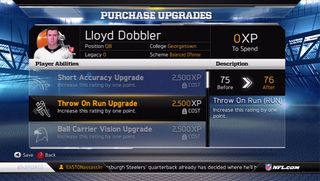
Progressing Your Player
This is easily the best and most appreciated new feature in Connected Careers. Previously, Madden progressed players automatically during the off-season, and it was really a crapshoot as to how much better/worse a player would become. Even if you had record-setting stats in multiple categories, players would often only increase a few points between seasons. Now, you not only have complete control over player progression, but you can even decide just what stats to improve.
Your performance dictates how much experience you’ll gain during a week. Progression can be done any time you see fit. There’s no limit to the amount of times you can progress your player, save for the amount of experience you have. Whether you’ve chosen to come into the league as a rookie, or take over the career of an established player, knowing which of your attributes you want to focus on improving is important. If you’re a cornerback with great Man Coverage, but you’re a bit weak in Awareness and Play Recognition, spending your first few week’s worth of experience in those areas will help you much more than continuing to increase your Man Coverage stats.
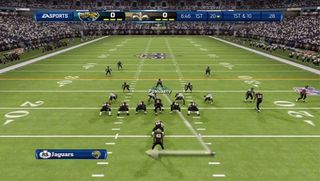
Playing a Game
Unlike Play Now or even the way you play a game in the coach’s Connected Career, you only get to play snaps when your player is on the field. You don’t play defense if you’re an offensive player. It’s also a bit different in that you only control your player as well. As a quarterback, once you hand the ball off or throw it to a receiver, the computer takes over. The only things that remain in your control are play-calling and pre-snap adjustments. You can still call timeouts as well, but for the most part, the player Connected Career is a very solitary experience.
If you happen to not be a starter, you’ll watch the game unfold from the simulation menu until you do make it on the field. If you’re the backup at a given position, you’ll find yourself on special teams for kick-offs and kick returns. Though you may have goals that are team-based, it’s important to remember to call plays that will focus on your player when he’s on the field. If you’re a linebacker, you should be blitzing, and calling for coverages that allow you to do what you must to pad your stats.
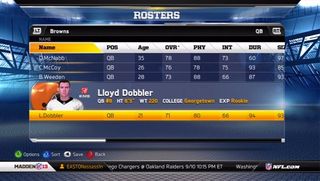
Post-Season
Those of you playing as NFL players will have nothing to do in the off-season. There’s no extra training to be done. You don’t have a say in any roster decisions the team makes. You can ask to be released or retire if you want, but that doesn’t really help your cause in making it to the Hall of Fame. You still have to simulate through all eight weeks of the post-season before you can do anything again. Once you do that, it’s back to the pre-season for 2013, and taking the next steps to make your career a memorable one.
Sign up to the 12DOVE Newsletter
Weekly digests, tales from the communities you love, and more
